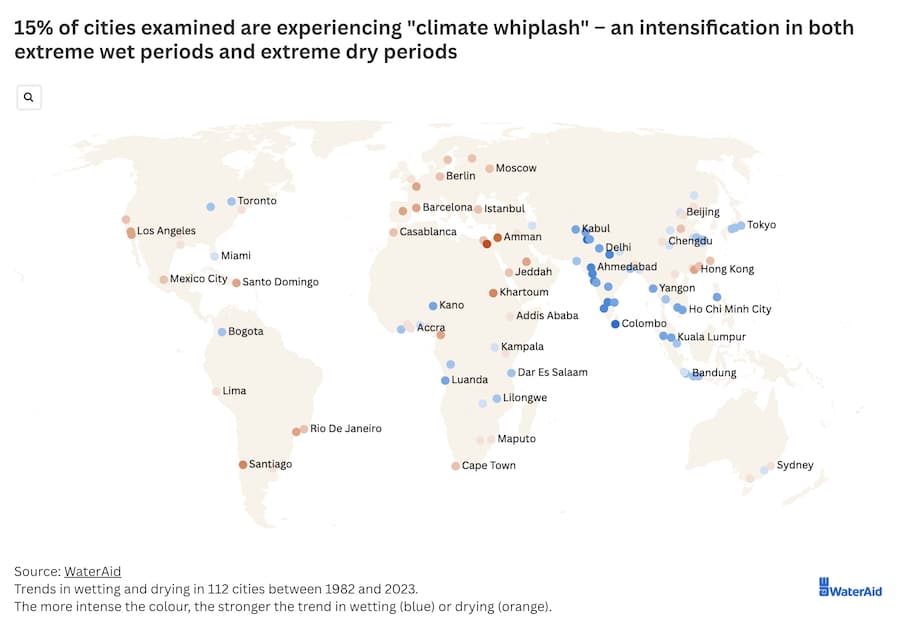Global Cities Under Siege: The Impact Of Dangerous Climate Whiplash

Table of Contents
Infrastructure Under Strain: The Physical Impact of Climate Whiplash
Extreme Weather Events and Urban Infrastructure
Urban infrastructure—roads, bridges, power grids, and water systems—is incredibly vulnerable to the extreme weather events fueled by climate whiplash. These events, ranging from intense heatwaves causing buckling roads to flash floods overwhelming drainage systems, cripple essential services and lead to significant financial losses.
- Examples of infrastructure damage: The 2021 heatwave in British Columbia caused widespread wildfires, damaging critical infrastructure, including power lines and transportation networks. Similarly, Hurricane Katrina’s impact on New Orleans' levees remains a stark example of infrastructure failure during extreme weather.
- Costs of repair and rebuilding: The economic cost of repairing and replacing damaged infrastructure after extreme weather events is astronomical, placing a huge burden on city budgets.
- Long-term maintenance challenges: Climate whiplash necessitates ongoing adaptation and maintenance of infrastructure to withstand increasingly frequent and intense weather events.
- Increased insurance premiums: The rising risk associated with climate whiplash leads to significantly higher insurance premiums for both businesses and individuals in vulnerable urban areas.
Sea Level Rise and Coastal Cities
Rising sea levels, a direct consequence of climate change and a key component of climate whiplash, pose an existential threat to numerous coastal megacities. The combination of storm surges and rising sea levels dramatically increases the risk of devastating flooding.
- Examples of cities at high risk: New York City, Shanghai, Miami, and Dhaka are among the many coastal cities facing significant threats from rising sea levels.
- Strategies for adaptation: Cities are investing in costly adaptation strategies, such as building sea walls, improving drainage systems, and even considering managed retreat for the most vulnerable areas.
- The economic cost of coastal defenses: Constructing and maintaining these defenses represents a substantial economic burden, requiring significant investments from both public and private sectors.
- The displacement of populations: Rising sea levels will inevitably lead to the displacement of populations from low-lying coastal areas, creating humanitarian crises and social disruption.
Economic Disruption: The Financial Toll of Climate Whiplash
Damage Costs and Economic Losses
The economic consequences of climate whiplash are profound, impacting city budgets and the bottom line of private businesses. The costs associated with repairing damaged infrastructure, compensating victims, and providing emergency services are immense.
- Examples of costly weather events and their economic consequences: Hurricane Sandy's impact on New York City resulted in billions of dollars in economic losses. Similarly, the 2022 Pakistan floods caused catastrophic damage to the country's infrastructure and economy.
- The impact on tourism and the service sector: Extreme weather events can severely disrupt tourism and the service sector, leading to job losses and reduced revenue.
- The increased burden on taxpayers: The cost of dealing with climate whiplash is ultimately borne by taxpayers, requiring increased taxes or cuts in essential public services.
Disrupted Supply Chains and Food Security
Climate whiplash severely disrupts global and local supply chains, impacting the availability and affordability of essential goods, including food. Extreme weather events can damage crops, disrupt transportation networks, and lead to food shortages.
- Examples of supply chain disruptions caused by extreme weather: Severe droughts can significantly reduce agricultural yields, while floods can damage transportation infrastructure and storage facilities.
- The effect on food prices and access: Supply chain disruptions often lead to increased food prices and reduced access to nutritious food, particularly for vulnerable populations in urban areas.
- The vulnerability of urban populations to food insecurity: Urban populations, often reliant on complex and globalized supply chains, are particularly vulnerable to food insecurity during periods of climate whiplash.
Public Health Crisis: The Human Cost of Climate Whiplash
Heat-Related Illnesses and Deaths
Extreme heatwaves, a hallmark of climate whiplash, pose a significant public health threat. Rising temperatures increase the risk of heatstroke, dehydration, cardiovascular problems, and respiratory illnesses.
- Statistics on heat-related deaths in cities: Numerous studies show a correlation between rising temperatures and increased heat-related mortality in urban areas. Heat islands, where cities are significantly warmer than surrounding areas, exacerbate the problem.
- Vulnerable populations (elderly, children): The elderly, children, and individuals with pre-existing health conditions are particularly vulnerable to heat-related illnesses.
- Public health strategies for mitigating heat-related illnesses: Cities need to develop and implement effective public health strategies to mitigate the impacts of extreme heat, such as early warning systems, cooling centers, and public health campaigns.
Spread of Infectious Diseases
Climate whiplash can alter the distribution and transmission of infectious diseases. Changes in temperature, rainfall, and humidity can create favorable conditions for the spread of vector-borne diseases like malaria, dengue fever, and Zika virus.
- Examples of diseases whose transmission is affected by climate change: The geographic range of disease vectors like mosquitoes is expanding due to rising temperatures, increasing the risk of outbreaks in new areas.
- The challenges of disease surveillance and control in urban areas: Monitoring and controlling the spread of infectious diseases in densely populated urban areas are particularly challenging during periods of climate whiplash.
- The impact on public health systems: Climate whiplash places significant strain on public health systems, requiring increased resources for disease surveillance, prevention, and treatment.
Conclusion
Climate whiplash is having a devastating impact on global cities, causing significant damage to infrastructure, disrupting economies, and creating public health crises. The unpredictable and intense weather events associated with climate whiplash pose a serious threat to urban populations worldwide. We must act decisively to mitigate the effects of climate whiplash on our global cities. This requires a multifaceted approach encompassing sustainable urban planning, investment in resilient infrastructure, and global cooperation to reduce greenhouse gas emissions and transition to cleaner energy sources. Let's work together to build more climate-resilient cities and protect vulnerable populations from the devastating impacts of climate change whiplash, dangerous climate shifts, and unpredictable weather patterns.

Featured Posts
-
 Todays Lowest Personal Loan Interest Rates A Comparison Guide
May 28, 2025
Todays Lowest Personal Loan Interest Rates A Comparison Guide
May 28, 2025 -
 Leeds United Transfer News Kalvin Phillips Return On The Cards
May 28, 2025
Leeds United Transfer News Kalvin Phillips Return On The Cards
May 28, 2025 -
 Comparatif Prix Samsung Galaxy S25 128 Go Economisez Jusqu A E
May 28, 2025
Comparatif Prix Samsung Galaxy S25 128 Go Economisez Jusqu A E
May 28, 2025 -
 Hanif Faisol Penanganan Sampah Di Bali Inspirasi Untuk Indonesia
May 28, 2025
Hanif Faisol Penanganan Sampah Di Bali Inspirasi Untuk Indonesia
May 28, 2025 -
 Liverpool Transfer Target Rayan Cherkis Potential Anfield Arrival
May 28, 2025
Liverpool Transfer Target Rayan Cherkis Potential Anfield Arrival
May 28, 2025
Latest Posts
-
 Norges Beste Badetemperaturer En Guide Til Sommerens Bading
May 29, 2025
Norges Beste Badetemperaturer En Guide Til Sommerens Bading
May 29, 2025 -
 Success Breeds Success Honda Bikes And Winning Riders
May 29, 2025
Success Breeds Success Honda Bikes And Winning Riders
May 29, 2025 -
 Book Your Luxurious 30 Minute Bubble Bath At Lush In Nyc 75
May 29, 2025
Book Your Luxurious 30 Minute Bubble Bath At Lush In Nyc 75
May 29, 2025 -
 Vaervarsel Og Badevann Finn Perfekte Badetemperaturer
May 29, 2025
Vaervarsel Og Badevann Finn Perfekte Badetemperaturer
May 29, 2025 -
 The Allure Of A Winning Honda Motorcycle
May 29, 2025
The Allure Of A Winning Honda Motorcycle
May 29, 2025
